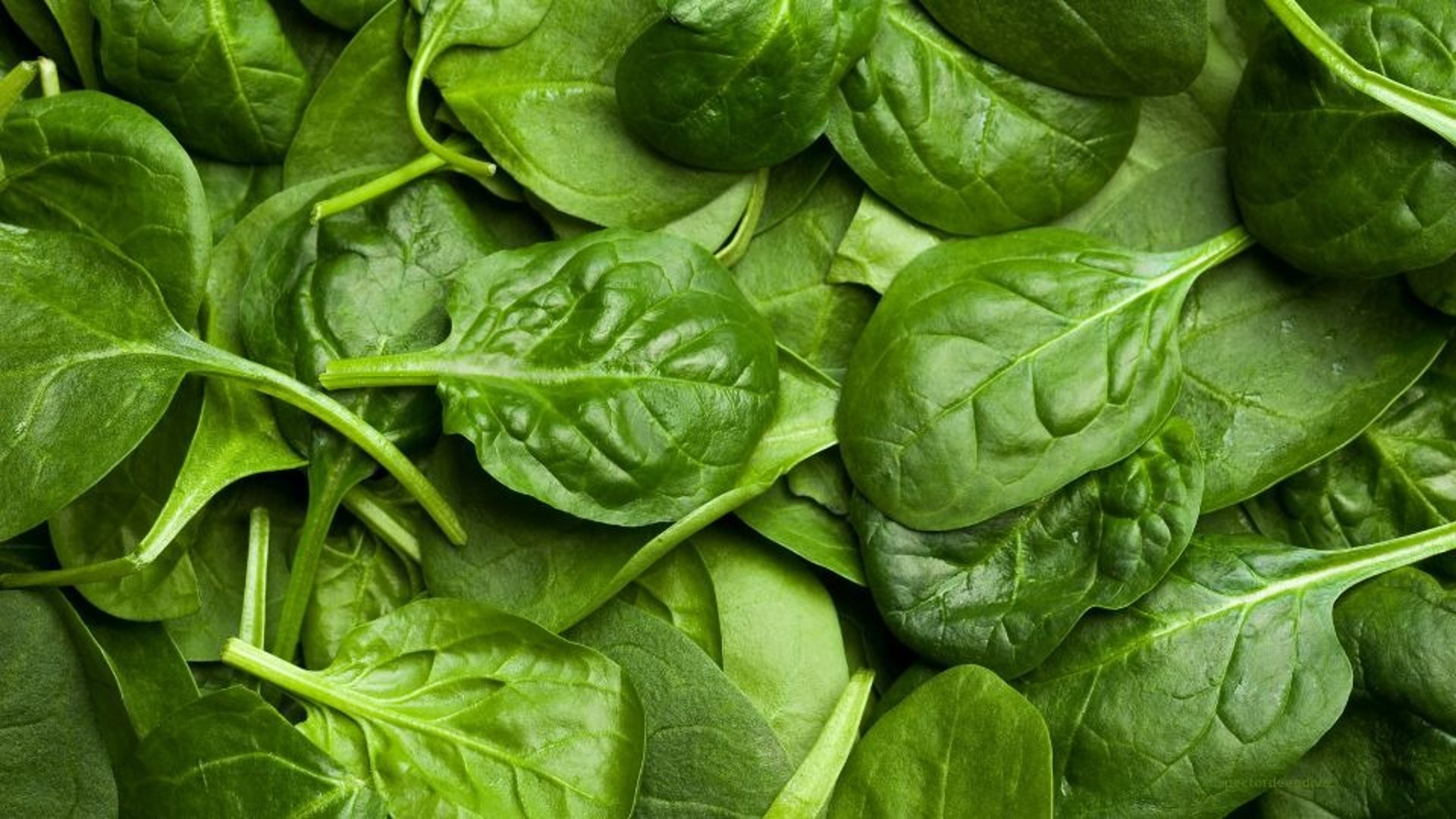
Spinach Health Benefits: Vitamins, Eye Health and Heart Support

Scientific name: Spinacia oleracea
Family: Amaranthaceae
A dark-green, nutrient-dense leafy green high in vitamin K, beta‑carotene, lutein and dietary nitrates excellent for eye health, bone support and cardiovascular function.
What it is
Spinach is a leafy green vegetable with tender, dark leaves and a mild, slightly sweet flavor. It is eaten raw or cooked and is valued for its high concentration of vitamins, minerals, antioxidants and dietary nitrates.
Where it comes from
Originating in ancient Persia (modern‑day Iran), spinach spread to China by the 7th century and into Europe by the 12th century. It grows best in cool climates and is now produced globally, with major producers including the United States, China and countries across Europe and Asia.
How many varieties
Common varieties:
Baby spinach tender, mild leaves
Savoy spinach crinkled, robust-flavored leaves
Flat-leaf spinach smooth leaves, easy to clean
Semi-savoy intermediate texture and flavor
New Zealand spinach & Malabar spinach different species used in hot climates
Seasonality & availability
Peak seasons: spring and fall in temperate climates. Fresh spinach is widely available year‑round thanks to greenhouse production and global trade; frozen spinach retains nutrients and is a convenient alternative.
Key benefits
Rich source of vitamin K (bone health, blood clotting)
High in beta‑carotene (vitamin A precursor) for vision and immunity
Contains lutein and zeaxanthin for eye protection (age‑related macular support)
Good source of folate for cell division and pregnancy health
Dietary nitrates may support blood pressure control and exercise performance
Provides fiber and a modest amount of plant protein for digestive and metabolic health
The Anti-Factor (oxalates) what to know
Definition: Oxalates are plant compounds that bind minerals (notably calcium and, to an extent, iron) and reduce their absorption. Spinach is relatively high in oxalates compared with many other greens.
Why it matters:
High oxalate intake can increase the risk of calcium‑oxalate kidney stones in susceptible people.
Oxalates reduce the bioavailability of some minerals; iron and calcium from spinach are less bioavailable than from some other foods.
How to reduce the effect:
Cook spinach (boiling or blanching) can reduce soluble oxalates by roughly 30–50% (varies with method).
Consume spinach with calcium‑containing foods (e.g., dairy) calcium binds oxalate in the gut and prevents stone formation while aiding mineral balance.
Stay well hydrated.
Rotate greens include lower‑oxalate greens (kale, arugula, romaine) in your diet.
Limit large, frequent servings if you have a history of kidney stones; consult a clinician.
Nutritional breakdown (per 50 g raw, approx)
Vitamins (per 50 g raw)
Vitamin K: 145 mcg, essential for blood clotting and bone health
Vitamin A (as beta‑carotene): 2,813 IU, supports vision and immune function
Vitamin C: 14 mg, antioxidant; supports immunity and collagen production
Folate (B9): 58 µg, important for DNA synthesis and pregnancy health
Vitamin E: 2 mg, antioxidant protection
Minerals (per 50 g raw)
Iron: 1.4 mg, supports oxygen transport (bioavailability reduced by oxalates)
Calcium: 30 mg, contributes to bone health (absorption affected by oxalates)
Magnesium: 24 mg, supports muscle/nerve function and energy production
Potassium: 167 mg, helps regulate fluid balance and blood pressure
Manganese: 0.4 mg, involved in metabolism and antioxidant defenses
Macronutrients (per 50 g raw)
Calories: 11 kcal, very low energy density
Water: 46 g, contributes to hydration
Protein: 1.4 g, plant protein for repair and satiety
Total fat: 0.1 g, negligible
Carbohydrates: 1.9 g, includes fiber and natural sugars
Dietary fiber: 0.7 g, aids digestion and fullness
Sugars: 0.4 g, naturally occurring
What spinach does to the body
Bone health: Vitamin K activates proteins (e.g., osteocalcin) that bind calcium into the bone matrix.
Eye protection: Lutein and zeaxanthin concentrate in the retina, help filter harmful blue light, and reduce oxidative stress.
Cardiovascular support: Dietary nitrates convert to nitric oxide, promoting vasodilation and potentially lowering blood pressure and improving blood flow during exercise.
Energy & oxygen delivery: Iron and folate support red blood cell formation and oxygen transport; absorption of non‑heme iron is improved when spinach is eaten with vitamin C.
Anti‑inflammatory & antioxidant actions: Carotenoids and flavonoids reduce oxidative damage and downregulate inflammatory signaling.
Risks & cautions
Oxalates: may increase kidney stone risk in susceptible individuals.
Vitamin K: high content can affect anticoagulant medication (warfarin); keep intake consistent and consult your clinician.
Pesticide residue: leafy greens can carry residues wash well or choose organic when needed.
Food safety: wash to remove soil and contaminants; store and use promptly.
Medication & supplement interactions
Warfarin and other vitamin K‑sensitive anticoagulants discuss diet consistency with your clinician.
Iron supplements: spinach is a plant source of iron; combining spinach with vitamin C improves iron absorption, but its iron remains less bioavailable than heme iron from animal sources.
Kidney disease: high‑potassium diets should be discussed with a clinician.
Storage & shelf life
Store unwashed spinach in the refrigerator crisper in a perforated plastic bag; use within 3–5 days for best flavor and nutrient retention.
Wash only before use to avoid accelerated spoilage.
Blanch and freeze for long-term storage (8–12 months) while preserving most nutrients.
Label reading tips
Look for bright, deep green leaves without yellowing or sliminess.
Baby spinach is tender but perishes faster; mature leaves store slightly longer.
Check "washed/ready-to-eat" bags for expiry dates and avoid those with excess moisture.
Environmental impact
Spinach is generally low‑to‑moderate in resource use but has a short shelf life contributing to potential food waste. Buying local and in‑season reduces transport emissions. Organic and integrated pest‑management farming improve sustainability.
Chef & culinary tips
Add spinach near the end of cooking to preserve color and many nutrients (except when you want oxalate reduction then blanch briefly and discard the water).
Combine with acidic ingredients (lemon, vinegar) and healthy fats (olive oil, avocado) to boost iron and carotenoid absorption.
Use raw in salads, wilted in sautés, blended into smoothies, or folded into soups, omelettes and pasta dishes.
5 Easy recipes / meal ideas
Spinach & Strawberry Salad with balsamic vinaigrette and toasted almonds.
Creamy Spinach & Mushroom Quiche use sautéed spinach folded into the egg custard.
Spinach-Banana Green Smoothie spinach, banana, Greek yogurt, and a splash of orange juice.
Garlic-Sautéed Spinach with lemon quick, bright side dish.
Spinach & Feta Stuffed Chicken Breast roast for a balanced meal.
Science behind it (compounds & mechanisms)
Carotenoids (lutein, zeaxanthin, beta‑carotene): antioxidants concentrated in eyes and tissues.
Nitrates: converted to nitric oxide supporting vascular function and exercise physiology.
Flavonoids and phenolic compounds: antioxidant and anti‑inflammatory effects.
Thylakoid membranes and peptides (emerging research): may influence satiety and blood pressure.
Recent scientific highlights (2024–2025)
Recent research has expanded understanding of spinach's role in human health and physiology:
Clinical studies have shown dietary nitrates from leafy greens can lower systolic blood pressure and improve endothelial function over weeks of consumption.
Trials indicate that regular spinach consumption may support cognitive performance by improving cerebral blood flow through nitrate-mediated pathways.
Meta-analyses report consistent associations between higher leafy-green intake and reduced risk of age-related macular degeneration, attributed largely to lutein and zeaxanthin.
Food‑science studies quantify how boiling or blanching can reduce soluble oxalates by roughly 30–50%, improving mineral availability while changing texture and some heat‑sensitive vitamin levels.
(These findings reflect a broad and growing evidence base; for clinical decisions consult original studies or a healthcare professional.)
Surprising truths
Frozen spinach can retain more vitamin content than fresh spinach stored for several days.
Spinach’s reputation for iron is nuanced: it contains iron, but oxalates reduce absorption pairing with vitamin C or low‑oxalate foods improves uptake.
Historically, spinach was introduced to Europe via Iberian and Mediterranean trade and became widely popular due to both flavor and quick-cultivation cycles.
FAQs
Q: Is spinach the best source of iron?
A: Spinach contains iron but its bioavailability is limited by oxalates. Pair spinach with vitamin C or include varied iron sources in the diet.
Q: How much spinach should I eat?
A: Regular inclusion (several servings per week) offers benefits. If you have kidney stone history or are on blood‑thinning therapy, consult your clinician for tailored guidance.
Q: Does cooking destroy nutrients?
A: Some vitamins (e.g., vitamin C) are heat‑sensitive and decline with cooking, while other compounds (e.g., lutein) may become more bioavailable; cooking reduces oxalates.
Final note
Spinach is a versatile, nutrient‑dense leafy green with clear benefits for eye, bone and cardiovascular health. Use a variety of preparation methods (raw, blanched, sautéed, frozen) to balance nutrient retention with oxalate management and culinary preference.
Spinach Health Benefits: Vitamins, Eye Health and Heart Support
info@inspectordeepdive.com
© 2025 food.InspectorDeepDive.com. All rights reserved. Content may not be copied or republished without permission.
This article is for informational purposes only. InspectorDeepDive.com does not provide medical advice. Always consult a licensed healthcare provider before making dietary or health decisions.
